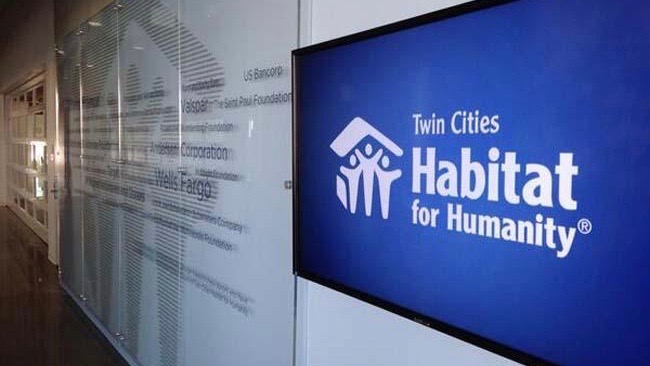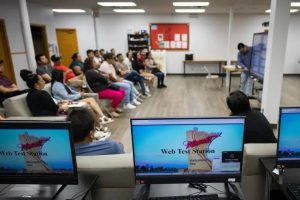
Q-and-A with Habitat for Humanity’s Chris Coleman and Cathy Lawrence
Some 4,000 volunteers will line up alongside employees of nonprofit Twin Cities Habitat for Humanity this week to build 30 houses for future low- to moderate-income homebuyers at the Heights, an environmentally sustainable community being installed at the 112-acre former Hillcrest Golf Course site on St. Paul’s East Side.
Chris Coleman. (Pioneer Press / John Autey)
It’s the nonprofit’s largest undertaking ever in the Twin Cities metro, boosted by the Jimmy and Rosalynn Carter Work Project. The Work Project — an annual homebuilding effort launched in 1984 by former President Jimmy Carter — draws corporate donors, lawmakers, faith leaders and business executives together for a week of homebuilding.
Participants include husband-and-wife country stars Garth Brooks and Trisha Yearwood, who have been involved with the builds since 2007, and Jonathan Scott of the reality show “Property Brothers.”
Twin Cities Habitat for Humanity helped new homeowners purchase a record 139 homes across the metro in its last fiscal year, about half of them built by Habitat and half purchased from the open market. The Work Project previously built homes in St. Paul and North Minneapolis in 2010.
The following interview with Twin Cities Habitat president and CEO Chris Coleman, a former St. Paul mayor, and his chief of staff Cathy Lawrence, the project lead for the week, has been edited for space and clarity.
Q: How did you land the Jimmy and Rosalynn Carter Work Project? Did you have to lobby hard for it?
CC: No, to be able to to pull off a project of this magnitude, you have to have a lot of capacity. And so obviously, we’re one of the larger affiliates in the Habitat world. And so they approached us and asked us if we’d be interested in hosting this year or next. They came out and kicked the tires. We talked a lot about what St. Paul was involved in, and how it’s different than it was in 2010. Hillcrest golf course was just a muddy hole, and we didn’t own the land at the time. Just the amount of work that has gone in since we were formally awarded the Carter Work Project…
Cathy Lawrence (Courtesy of Twin Cities Habitat for Humanity)
Q: But now you own the land, and there’s already been some site prep?
CC: We have foundations poured. We have some of the larger units, the four-plexes that have already framed up, and we’ll be doing inside work on on those. It’ll be probably next spring by the time the first families are able to move in. That’s fairly typical. If we can get a unit closed up and and then we unleash what we call our “winter warriors,” folks that volunteer all year round, they come in and do the finishing on it (even before there’s a homeowner lined up).
Q: Habitat’s old “sweat equity” model was that the volunteers would come and work on their future house, right? And you’ve kind of flipped that around a little.
CC: We really have gone away from that concept of sweat equity for a lot of different reasons, but one of them was it made it really, really difficult for a lot of our families to buy. If you have three kids and you don’t have ready access to free child care, if you don’t have time off, or have limited time off from your job, coming out and volunteering for 300 or 400 hours was a huge burden. So when we put an equity lens on the work that we were doing, we realized that — particularly in the African American community, the foundational Black community — that was cited frequently as the reason why they weren’t working with Habitat for Humanity.
Q: When did you make that shift?
CL: Officially, it went in a year ago last April, so the beginning of last construction. We hadn’t had prospective families out with us since COVID. So obviously everything shut down. That allowed us to take a really close look at the program because it had paused and as Chris mentioned, we’re going through a very introspective look at what barriers we unintentionally created for people, and that was one of them. So then we worked through COVID, and then our board approved it in February of that year, and we started to roll it out. This is the second build season that we’ve had the ‘Volunteer and Learn” program instead.
Q: How is “Volunteer and Learn” different?
CL: Our volunteers are so incredibly important to us. It’s the way we make our mission happen, and we treat our prospective homebuyers and homeowners the same. So they have opportunities to come out and volunteer. We did believe sweat equity was a good partnership model, and we did believe that there were benefits to kind of learning some things about your house. I’ve been a homeowner like four different times. I never built any of my homes. I think I’ve been a pretty good homeowner, but did somebody teach me how to change a filter? Yes. So it’s much more geared to making them successful homeowners. But if they want to come out and learn how to sheetrock so they can finish off their basement, we will host that sort of activity for them to come and do that — not a requirement at all.
Q: Has it made a difference?
CC: We went from 8% of our families that successfully completed the homeownership journey were foundational Black households. Now that figure officially last year was 22%. That’s a huge piece of it, but it’s how we’ve engaged in community, who we’ve worked with, and the partnerships that we brought to the table have really been focused in on expanding opportunities for foundational Black households to purchase homes.
Q: There’s been a slowdown in housing construction citywide, if not nationally, and with Sherman Associates and the JO Companies at the Heights. A lot of that has to do with things like interest rates and the tighter lending markets, but it seems like Habitat’s been able to move forward.
CC: They just have different considerations, like the issues around rental housing right now. They’re just different challenges. For us, the challenge certainly has been the interest rates. It’s just increased the gap between what a family can afford and what the potential cost of housing is. So that’s where we’ve really had to work very closely with partners, from both philanthropic funders and government partners, just working to close that gap for the families.
CL: My sense is at the Heights that Sherman and JO Companies are following a fairly typical development plan. We did not because we had the Carter Work Project coming. We really accelerated it, and that had its own set of circumstances, and we plowed through it. I don’t know that we would have been on the ground until probably next spring if we hadn’t really pushed this year because of the Carter Work Project.
Q: Did it free up some funding to have the Carter Work Plan here?
CC: We had to raise an additional lump of cash to be able to put the project on, so we’ve raised cash and in-kind donations, around $12 million, including $2 million from Habitat International. We had partners like Andersen Windows that donated all the windows for the Work Project, and we can thank GAF for all these solar shingles. That’s one of the things we like to brag about, too — on this site the sustainability is going to be really, really comprehensive and far reaching. Instead of installing solar panels, the actual shingles on the roof are going to be solar collectors. This site has no gas lines in it. It’s pretty unique.
Q: You’re not just a homebuilder. Habitat has become an official mortgage lender, right? What does that mean for Habitat and for your clients?
CC: We have been below-market on our interest rate because of the partnership that we’ve had with Bremer Bank, but we were at 2% and now we’re just above 5% after rates just went down. So we’re still below market, which helps. But that jump of three percentage points was pretty significant. It just means that we’ve got to work to set the price of the mortgage for the family at 30% of their household income, and that figure hasn’t gone up substantially. The salaries of the families aren’t going up anywhere near what the cost of housing is going up, or what interest rates did. So that just means we need to fill a bigger gap.
CL: We have to tap more into philanthropic resources and in some cases, public funding. The Legislature and the governor made a big housing investment a couple years ago in the housing bill. A lot of those resources were in down-payment assistance that our families can tap into. It’s one-time money that we got.
Q: How are you going to market these homes?
CC: Well, that’s a good question. That is something that we have been working on, really, from from the get-go, because we’re creating a new neighborhood on the East Side, so we work very closely with the East Side district councils. They’ve been a great partner with us. We are working with a marketing firm that will come in, just to get the word out. This will be something that we’ve never done before, but we may even have a model unit on site for people to come and look at, maybe even before the units are finished.
CL: One of our challenges for years has been that our brand can sometimes get in our way. So people often think that they aren’t a candidate to become a Habitat homeowner. We don’t give the houses away. People are paying at below-market mortgage locked into 30% of their income. Our client’s household incomes generally are between $50,000 and $100,000. It is school aids and bus drivers and a lot of healthcare workers. And for the last few years, we have partnered with employers who we think have on staff exactly that target population. So we have partnered with Alina and HealthPartners. It could be their call centers, it could be all sorts of places. In addition to that, it’s places that run really significant maintenance facilities. It’s not necessarily targeting their clients. It’s actually targeting their staff.
Our 139 closings last year were not just Habitat-built homes. People have an opportunity to partner with their own real estate agent, find a house in the community that they want to live in, and use our programming and our mortgage to close on that house. Because of the partnership with Bremer, we were able to expand that. And it’s been a game changer for families. And, you know, it’s quicker. Now, a lot of families still want our Habitat homes, because they’re brand new and they’re in neighborhoods they want to be in. But the open market is also very attractive.
Related Articles
Letters: Which states would we give up to a foreign invader?
St. Paul: Habitat for Humanity build and concert event coming to the Heights development this week
St. Paul man sentenced on gun charge after shooting during carjacking attempt on city’s East Side
Homes by Architects Tour this weekend debuts ‘Small Projects Showcase’ — including a ‘Tiny Tudor’ in St. Paul
Gear up for winter during St. Paul’s Snow Summit


